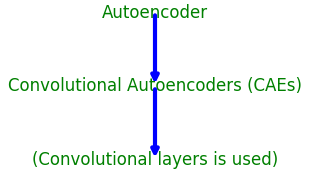=================================================================================
Autoencoders are neural network architectures used for unsupervised learning and dimensionality reduction. They consist of an encoder and a decoder, and the hidden layer of the encoder can be seen as representing latent features. The network learns to encode and decode data in a way that minimizes reconstruction error, effectively learning a compact representation of the data.
Autoencoders and Convolutional Autoencoders are both types of neural networks used for unsupervised learning, but they have differences in their architecture and use cases.
-
Autoencoders:
- Autoencoders are a type of neural network used for data compression and feature learning.
- They consist of an encoder and a decoder. The encoder compresses the input data into a lower-dimensional representation (encoding), while the decoder reconstructs the original input data from the encoding.
- Autoencoders can be fully connected, meaning all neurons in one layer are connected to all neurons in the next layer. This type is often called a "fully connected autoencoder" or "dense autoencoder."
- Convolutional Autoencoders:
- Convolutional Autoencoders (CAEs) are a specific type of autoencoder designed for processing grid-like data, such as images.
- They use convolutional layers in both the encoder and decoder parts of the network. Convolutional layers are well-suited for capturing spatial patterns in data, making CAEs particularly effective for image denoising, image generation, and feature learning in computer vision tasks.
- In the encoder, convolutional layers are used to extract hierarchical features from the input image, and in the decoder, transposed convolutional layers (sometimes called "deconvolution" or "up-sampling" layers) are used to reconstruct the image.

Convolutional layers and padding are used in autoencoders for several reasons:
-
Feature Extraction: Convolutional layers are particularly effective at capturing local patterns and features in an image. They use small filters to slide over the input data, identifying features like edges, textures, and more complex structures. This feature extraction ability is crucial for autoencoders to learn meaningful representations of the input data.
-
Translation Invariance: Convolutional layers are translation invariant, meaning they can identify patterns regardless of their exact position in the input. This is important because in many applications, the same features can appear in different locations within an image. Convolutional layers help the autoencoder focus on what features are present rather than where they are.
-
Reduced Parameter Count: Convolutional layers have a smaller number of parameters compared to fully connected layers. This parameter efficiency is essential for training deep neural networks, as it helps prevent overfitting and reduces computational requirements.
-
Hierarchical Features: Convolutional layers are typically stacked in a hierarchical manner. This allows them to capture features at different levels of abstraction, from simple edges to complex shapes and objects. Autoencoders benefit from this hierarchical feature representation as it helps in encoding and decoding the input data effectively.
Padding, on the other hand, is used in convolutional layers to control the spatial dimensions of the output feature maps. There are two common types of padding:
-
Valid Padding: No padding is added to the input, and the convolution operation reduces the spatial dimensions of the feature maps. This can lead to a loss of spatial information at the edges of the input.
-
Same Padding: Padding is added to the input in such a way that the output feature maps have the same spatial dimensions as the input. This helps preserve spatial information and is often used when you want to maintain the same spatial resolution between input and output in autoencoders.
Table 3883. Applications and related concepts of Autoencoders.
============================================
|
